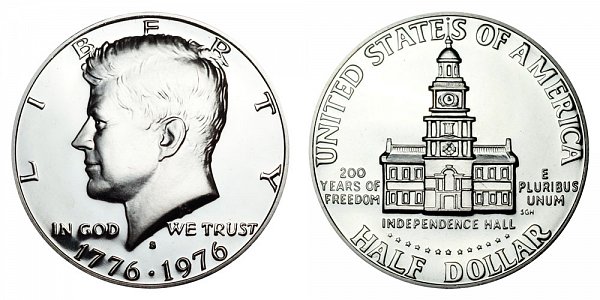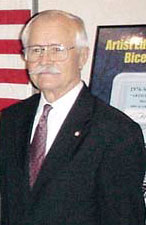Seth G. Huntington
US Coin Designer and Engraver - Bicentennial Half Dollar
Seth G. Huntington was born on February 12, 1920 in Minneapolis, Minnesota. During his earlier years in art, Seth had developed a talent for sculpting and working with pottery. He went on to attend and graduate from the Minneapolis College of Art to study art and perfect his skills. After becoming more experienced, he was hired to become part of faculty at St. Paul Arts and Science Center located in the Twin Cities area of Minnesota. One type of art that he specializes in is sculpting small, but highly detailed pieces of art in the form of wax and then cast in sterling. Some of his other artwork deals in corporate design, book illustration, educational materials and advertising. Seth Huntington had received many citations and earned numerous awards. One of the awards he had won was the annual Printing Industries of America award for graphic arts, which he won twice before his most famous accomplishment. Also at that time, Seth worked as manager and art director for a company called Custom Art Department of Brown and Bigelow, which was the largest calendar and advertising specialty house known in the world at the time.
Seth Huntington is most famous nationally for designing the reverse of the Bicentennial Half Dollar, which depicts Independence Hall. Back in October, 1973, the nation was ready to celebrate the 200th Anniversary of the birth of the United States. One exciting way the nation was going to honor and commemorate the US Bicentennial, was to re-design our currency. So the Treasury decided to open a competition up to the public to design new reverses for the US Quarter, Half Dollar and Dollar coinage. Huntington was one of those sculptors who would submit his design.
Huntington submitted his design for the Kennedy Half Dollar coin. There were over 15,000 inquires and 884 other designs submitted to the US Mint throughout this contest. On March 6, 1974, the US Mint announced that Huntington's design would be chosen for the Half Dollar and that he had won a $5,000 prize. The other two winners included Jack L. Ahr, who had designed the Bicentennial Quarter, and Dennis R. Williams, who had designed the Bicentennial Dollar. One of the fived judges included the famous Gilroy Roberts, the former US Mint Chief Engraver who had originally designed the obverse bust of Kennedy on the Kennedy Half Dollar.
The front of the coin depicted the same bust of Kennedy that Roberts designed, but the date was 1776-1976. The reverse of the coin, that Huntington designed, depicted the portrait of Independence Hall, the building in Philadelphia, Pennsylvania. Independence Hall is where the Constitutional Convention took place, the Declaration of Independence was signed and where the US Constitution was drafted. Essentially, this site is where the United States was officially born. On the reverse of this coin, the text "INDEPENDENCE HALL" is displayed under the building, "200 YEARS OF FREEDOM" is also displayed to the left of the building, and our motto "E PLURIBUS UNUM" shows up on the right side of the building. Seth G. Huntington's initials "SGH" show up just below the motto.

Design of the Bicentennial Kennedy Half Dollar. Reverse with Independence Hall designed by Seth G. Huntington.
On April 24, 1974, Seth and the other winners were invited to the White House and later went to the Treasury to receive their $5,000 prizes. Later that year on August 12, 1974, all three winners were invited to the Philadelphia Mint where they got to operate the minting press and ceremoniously strike the very first coins that they designed. These coins were prototypes which did not have a mint mark on them. The next day, these new coins were sent to the American Numismatic Association in Florida, where the coins would be exhibited.
The Bicentennial Half Dollars were produced in 1975, but was not authorized to be released to the public until July 4, 1975 and would continue being produced until January 1, 1977, when the old designs would be brought back again. Although the first bicentennial coinage to be released was the half dollar coin on July 7, 1975, which coincided with ceremonies happening in Minneapolis, the hometown of Seth Huntington. In all, over half a billion bicentennial Kennedy half dollars were produced. The US Mint wanted to make these coins available for everyone since so many people hoarded them up and kept them as mementos and commemorative collectibles. Even the West Point Mint assisted the Philadelphia Mint in striking this many coins, although their mint mark does not appear on the coins and there is no way to tell the difference between the coins minted in West Point and Philadelphia.
These coins were struck in the copper-nickel clad composition of 91.67% copper and 8.33% nickel. Although the San Francisco Mint struck 11 million silver composition coins consisting of 40% silver and 60% copper. These were meant just for collectors and were not intended for general circulation. Only a decade before, the US had ended silver currency because the melt value of silver coins was so high due to the silver content. The coin's metal was worth more than the face value of the coin, so people began hoarding them and melting them down. So these silver coins were minted especially for the collectors and would be sold at higher than face value prices.
At the start of 1977, the Mint resumed the original Kennedy Half Dollar obverse design by Gilroy Roberts and the eagle reverse design by Frank Gasparro. Seth Huntington's half dollars are some of the most widely collected commemorative coins around, considering that they were only produced for about 2 years. During the time this coin was produced, he was happily married with 8 children and 2 grandchildren.
